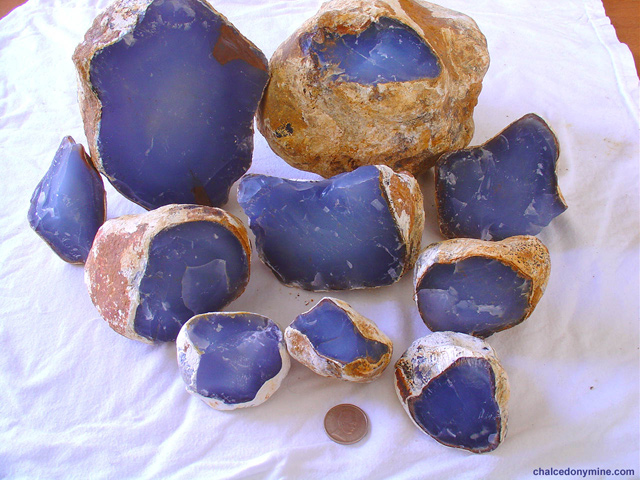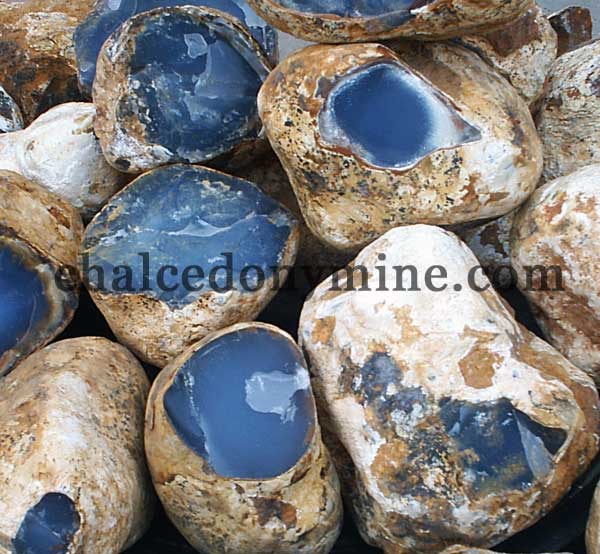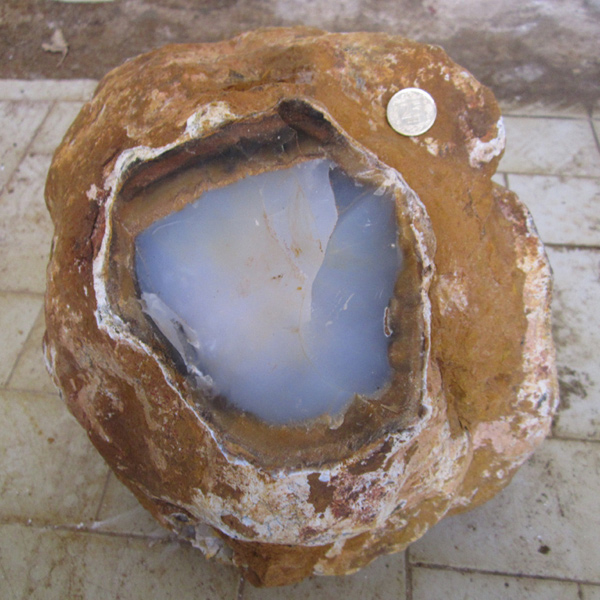Discover the mesmerizing world of blue chalcedony, one of the most stunning minerals found on Earth.
The Beauty of Blue Chalcedony: Exploring the Earth's Most Exquisite Minerals
Blue chalcedony is a mineral that captivates the eye with its stunning blue hues. It is a type of quartz that forms in a variety of settings, from volcanic environments to sedimentary rocks. Its unique beauty and rarity make it a popular choice for jewelry and collectors alike.
The Formation of Blue Chalcedony
Blue chalcedony is a fascinating mineral that has captured the attention of geologists and gem enthusiasts alike. Its unique composition and stunning blue hues make it a prized addition to any collection. But how exactly is this mineral formed?
The process of blue chalcedony formation is a geological marvel that spans millions of years. It involves a complex interplay of environmental factors, such as the deposition of silica-rich fluids and the infiltration of rocks.
The Geological Process Behind Its Creation
The formation of blue chalcedony is a complex process that involves various geological factors. It starts with the deposition of silica-rich fluids in cavities or fractures of rocks. This may occur in a volcanic environment or in sedimentary rocks.
Over time, these fluids slowly infiltrate the surrounding rock and fill the cavities or fractures, forming a gel-like substance. This substance is composed primarily of silica molecules that have accumulated and bonded together.
As the gel-like substance hardens, it forms the compact mineral that we call chalcedony. This process may take millions of years, as the mineral undergoes various changes and transformations that affect its color and composition.
The Role of Silica in Chalcedony Formation
Silica is a crucial component of chalcedony formation. It is the primary building block of the mineral and is responsible for its unique attributes, such as its hardness, color, and luster.
The silica molecules slowly accumulate over time as fluids seep into the cavities or fractures of the host rock. As they accumulate, they form a gel-like substance that hardens into the compact mineral we call chalcedony.
It is worth noting that silica is one of the most abundant minerals on Earth, and is found in a wide range of geological environments. This means that chalcedony can be found in many different locations around the world, each with its own unique characteristics and attributes.
The Influence of Environmental Factors on Color
One of the most striking features of blue chalcedony is its stunning blue hues. But what exactly gives this mineral its distinctive color?
The color of blue chalcedony is influenced by various environmental factors, such as the presence of impurities and the conditions under which it was formed.
For example, blue chalcedony can range in color from light blue to deep navy blue, depending on the levels of impurities present. Iron and copper are common impurities found in blue chalcedony and contribute to its distinctive blue hues.
Other factors, such as the temperature and pressure conditions under which the mineral was formed, can also affect its color and composition. This is why chalcedony can be found in such a wide range of colors and patterns, each with its own unique story to tell.
In conclusion, the formation of blue chalcedony is a geological marvel that involves a complex interplay of environmental factors. From the deposition of silica-rich fluids to the infiltration of rocks, this mineral undergoes a fascinating transformation that results in its unique composition and stunning blue hues. Whether you are a geologist or a gem enthusiast, blue chalcedony is a mineral that is sure to captivate your imagination.
The History and Cultural Significance of Blue Chalcedony
The beauty of blue chalcedony has been appreciated for centuries by various civilizations around the world. It has been used for everything from jewelry to decorative objects, and even in religious ceremonies.
Ancient Civilizations and Their Use of Chalcedony
Ancient civilizations, such as the Greeks and Romans, prized chalcedony for its beauty and durability. They used it to make jewelry and decorative objects, and even incorporated it into religious ceremonies. The Greeks believed that chalcedony had the power to ward off evil spirits and bring good luck to the wearer.
The ancient Egyptians also valued chalcedony and believed that it had healing properties. They used it in various amulets and other objects, and even included it in their funerary preparations. It was believed that chalcedony would help the deceased on their journey to the afterlife.
The ancient Persians and Babylonians also held chalcedony in high regard, using it for seals and signets due to its hardness and durability.
Symbolism and Spiritual Properties
Chalcedony has long been associated with various religious and spiritual beliefs. In ancient times, it was believed to bring good luck and protect against evil spirits. It was also used as a talisman for travelers.
In modern times, chalcedony is believed to have various healing properties, ranging from promoting emotional balance to enhancing communication skills. It is also used as a meditation aid and for enhancing spiritual growth. Some people believe that chalcedony can help with insomnia and promote peaceful sleep.
Chalcedony is also associated with the throat chakra, which is believed to be the center of communication and self-expression. It is said to help individuals express themselves more clearly and confidently.
Chalcedony in Modern Jewelry and Art
Today, blue chalcedony is a popular choice for jewelry designers and collectors alike. Its striking blue hues make it a desirable gemstone for everything from rings to necklaces and earrings. Chalcedony is also used in other forms of jewelry, such as bracelets and pendants.
Artists and sculptors also appreciate the unique beauty of chalcedony and use it in their works. Its translucent quality and wide range of colors make it a versatile material for a variety of applications. Chalcedony can be carved into intricate shapes and designs, making it a popular choice for decorative objects and sculptures.
In addition to its use in jewelry and art, chalcedony is also used in industrial applications. It is used as an abrasive in polishing and grinding, and is also used in the production of cement and ceramics.
Overall, the history and cultural significance of blue chalcedony is a testament to its enduring beauty and versatility. From ancient civilizations to modern times, chalcedony has been valued for its aesthetic appeal and believed to possess various healing properties.
The Many Varieties of Chalcedony
Chalcedony is a type of mineral that belongs to the quartz family. It is composed of microscopic crystals of quartz that are arranged in a fibrous or microcrystalline structure. This mineral comes in a variety of colors and types, each with its own distinct properties and characteristics.
Comparing Blue Chalcedony to Other Colors
Blue chalcedony is a beautiful and popular variety of chalcedony. It is often compared to other types, such as black onyx, white chalcedony, and pink chalcedony.
Black onyx is a dark, opaque variety of chalcedony that is often used in jewelry. It has a smooth and glossy surface that makes it an ideal choice for carving intricate designs. White chalcedony, on the other hand, is a translucent, colorless variety that is prized for its ethereal beauty. It is often used in decorative objects and as a substitute for more expensive gemstones like diamonds and sapphires. Pink chalcedony is a pink-hued variety that is often used in decorative objects and jewelry. It has a soft and delicate color that can range from pale pink to deep rose.
Distinguishing Features of Different Chalcedony Types
Each type of chalcedony has distinct characteristics that set it apart from others. For example, blue chalcedony has a hardness of 6.5-7 on the Mohs scale, making it a durable gemstone for jewelry. It is also known for its beautiful and calming blue color, which can range from pale sky blue to deep navy blue. White chalcedony has a lower hardness of 6-7 and is more prone to scratching and chipping. It has a milky and translucent appearance that can resemble the look of moonstone.
Black onyx has a Mohs hardness of 6.5-7 and is more opaque than other varieties. It is often used in men's jewelry and has a sleek and sophisticated look. Pink chalcedony is a softer variety, with a Mohs hardness of 6-6.5. It is often used in delicate and feminine jewelry designs.
The Rarity and Value of Blue Chalcedony
Blue chalcedony is a relatively rare gemstone compared to other varieties of chalcedony. It is found in a few locations around the world, including Turkey, Namibia, and the United States. This rarity can contribute to its value, making it a sought-after gemstone for collectors and jewelry designers. Blue chalcedony is often used in statement jewelry pieces, such as cocktail rings and pendant necklaces, due to its unique and eye-catching color.
In addition to its beauty and rarity, blue chalcedony is also believed to have healing properties. It is said to promote calmness and tranquility, as well as enhance communication and creativity. Many people wear blue chalcedony jewelry as a way to connect with these energies and improve their overall well-being.
The Healing Properties and Metaphysical Benefits of Blue Chalcedony
Blue chalcedony has been prized for its healing properties and metaphysical benefits for centuries.
Emotional and Mental Healing
Blue chalcedony is believed to promote emotional balance and help alleviate anxiety and depression. Its calming energy can help soothe the mind and promote inner peace.
Physical Healing Properties
Blue chalcedony is also believed to have various physical healing properties. It is said to help with ailments related to the throat and respiratory system, such as sore throats and coughs. It can also help ease tension in the muscles and joints.
Enhancing Spiritual Growth and Meditation
In addition to its healing properties, blue chalcedony is believed to help enhance spiritual growth and meditation. Its soothing energy can help quiet the mind and promote a deeper sense of awareness.
Conclusion
Blue chalcedony is a rare and exquisite gemstone that has captured the hearts of people for centuries. Its unique beauty, combined with its metaphysical properties, make it a desirable gemstone for jewelry designers and collectors alike. Whether you are drawn to chalcedony for its beauty or its healing qualities, it is a mineral worth exploring in depth.

Halved Blue Chalcedony Nodule
We understand the importance of customer satisfaction. That's why we offer great customer service and fast shipping to ensure a hassle-free shopping experience. We're committed to providing you with the best chalcedony products and service.

Top grade blue chalcedony lot
Thank you for choosing our store as your go-to source for rough blue chalcedony. Browse our collection today and discover the beauty and power of this mesmerizing crystal.
Click to see available stones on our eBay store

Big and flawless nodules available look like below for processing to make carving and bangles

Big boulder
